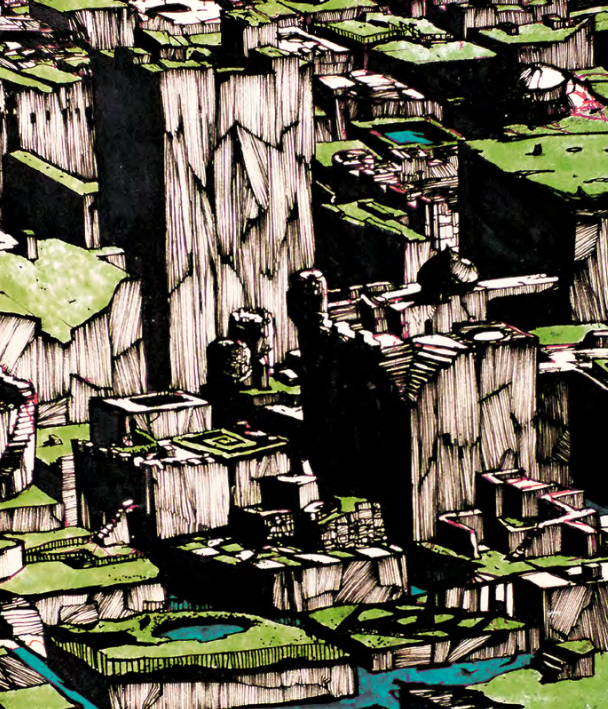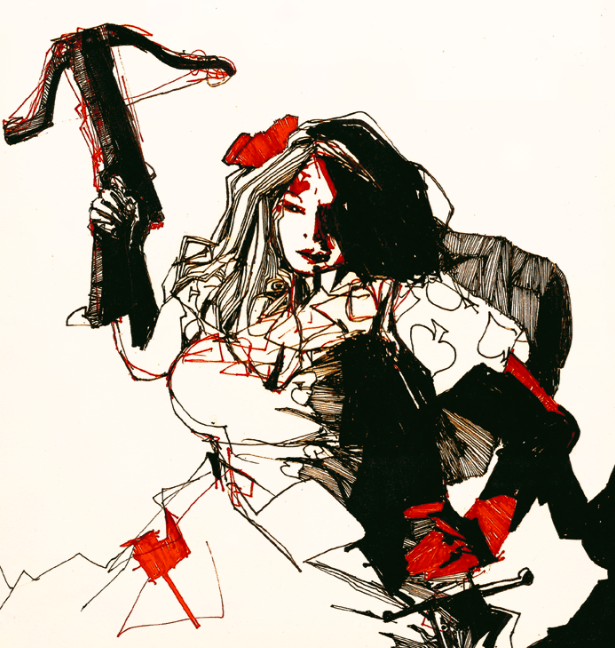Review: A Red and Pleasant Land
by Ramanan Sivaranjan on December 30, 2014
Tagged: lotfp osr zaksmith art rapl
Wife is now fooling around on the tablet I bought so I have email access when traveling. It has the Alice in Wonderland books preloaded on it and she is amazed.
Me, I’m suddenly struck by the idea of putting a young blonde in a blue dress on the cover of an adventure I’d call “Eat Me.” — James Raggi, August 23rd, 2012
A little over two years ago James Raggi mentioned in passing this idea of doing an Alice in Wonderland Adventure. Zak S replied with a phrase that became a bit of a joke on G+: “For a modest advance…” Presumably there was a modest advance, because here we are.
Zak would occasionally share bit and pieces of the book he was working on on his blog: artwork he had finished, or a table or set of rules he had written. I helped play test the module a few times: once with my OD&D group, a couple times with Zak himself, and most recently with Kiel just as the final layout for the book was wrapping up. Zak used a photograph of me as a reference for the Knave of Hearts, after asking for photographs on G+. I have been watching in real time as this book slowly came together. I bring this all up to try and highlight just how much I have been anticipating this book, how completely unrealistic and unfair the expectations I have placed on the final product are, and to suggest that I am perhaps too emotionally invested in this book to review it properly.

A Red and Pleasant Land is a setting book that describes Voivodja, the Land of Unreason. Rather than using the travel guide gazetteer format commonly used for these sorts of things—which, if we are being honest with one another, suck—A Red and Pleasant Land presents its world primarily via elements that are all usable at the gaming table: dungeons, monsters, new rules, and random tables. A Red and Pleasant Land is more about helping a DM build their own version of Voivodja than presenting some canonical version of the place. In this way is reminds me of Carcosa.
A Red and Pleasant Land begins with a brief overview Voivodja. It’s 18 pages long and is probably the only part of the book you’d be expected to read beforehand if you wanted to run things by the seat of your pants. The book starts off with a discussion of what makes this place different than your typical fantasy setting. The history, geography, and culture of Voivodja is examined at a very high level. Mixed in with all of this is advice on how to use the book and run a game in Voivodja: this is something more books should do. Much of this section of the book is adventure hook fodder. (Croquet, a staple of Alice in Wonderland, is presented as an obvious source of adventure: players might play to get an audience with the queen, be hired to track down a obscure wickets, etc.) Voivodja is a strange land where a king and queen have been waging war upon one another for time immemorial. Two other factions have decided to enter this fray, both deciding who to ally themselves with as the adventure begins. The setting is designed to support a game built around the conflict that comes from the players interacting with various NPCs with conflicting goals.

To go along with the new setting is a new character class, the Alice. The character is an interesting twist on the Specialist from LotFP. Every time the character gains a level a percentile die is rolled: this may lead to new powers or bonuses inspired by the events in Alice’s Adventures in Wonderland rather than simply gaining more skill points or saving throw improvements. The Alice also has the ability to get exasperated. Doing so lets them roll on an exasperation table, which may lead to the sorts of strange events, again clearly inspired by Alice’s Adventures in Wonderland: a door appearing out of nowhere, something that normally wouldn’t be able to talk suddenly starts talking, etc. I played an Alice during the play test for A Red and Pleasant Land, but didn’t take advantage of this power—i’m boring I suppose.
A look at the new monsters and NPCs of this world is up next. There are 4 factions in Voivodja, led by: the Heart Queen, the Red King, the Pale King, and the Colourless Queen. Beyond your typical stat block, almost all the creatures in this book have relationships or alliances that could lead to adventure and conflict. This also helps present the setting to the players. Most of the monsters in the book are quite interesting. I particularly liked the Guests, which are basically demons. A Red and Pleasant Land features a great random demon generator that you could steal for any fantasy game. There is also a Brown vampire: trés fantastique! There is an illustration for almost every creature presented. Hopefully you know what a horse looks like.
There are two dungeons presented in detail in A Red and Pleasant Land: the Heart Queen’s palace, and the Red King’s castle. They are both fucking bonkers. Of the two I love the Heart Queen’s castle the most. The games I have played exploring that dungeon have been some of the most fun I’ve had playing D&D. I think they are both well executed and interesting: big enough and weird enough to support multiple sessions of play.
The book concludes with some new rules and then some random tables. (Of course it does.) As I mentioned in my last post about A Red and Pleasant Land, Kiel used these tables to generate an adventure for us to play more or less on the spot, without anyone really noticing what was going on. That seems like high praise for this portion of the book. My favourite title in the whole book is found in this section: “Idiotic Voivodja Filibuster Conversation Openers”. There are lots of great tables, many of which would work in other settings. All games need a “where have you been?” table for when a player shows up late or misses a session, and a good “I search the body” table can tell the players a lot about the world they playing in.

Like Vornheim, A Red and Pleasant Land is as much a book about a particular setting as it is a treatise on how one should go about writing and presenting a setting in general. Zak has clearly approached this problem from the perspective of someone sitting at a gaming table. How much information does the DM need to successfully run a campaign set in this world? How do you best present it all? What things need to be quickly referenced? These are questions that seem to be rarely asked by most authors and publishers, including Wizards of the Coast. This book is worth buying as an example of good graphic design, even if you aren’t interested in Dungeons and Dragons.
The two large dungeons presented in the books are a perfect example of this attention to detail when laying out a page of text. The map of the outer defences of the Red King’s castle, along with the descriptions of the rooms on the map, all fit on a two page spread. Most sections of this palace have cutaways maps along with descriptions that fit on one or two page spreads. Occasionally you will need to flip back a page to see a map, but this hardly feels onerous compared to the typical presentation of dungeons in most modules. Room descriptions are all bullet point rather than long paragraphs, making it easy to quickly figure out what’s going on. There is no superfluous text. This is true throughout the book. Blocks of text that might need to be looked at during a game are usually presented as bulleted lists, while sections of the book that will likely be read before or after a gaming session are often longer and more flowery.
This level of thoughtfulness permeates the whole book. There are next to no tables that don’t fit neatly on a single page, or aren’t part of a tidy two page spread. (The few tables that are too big for a two page spread are clearly marked as spilling over to the next page.) Beyond the dungeons and the rare monster, there is basically nothing in this book that would require you to flip a page to get all the information you need.
The layout of this book is really stunning. Jez Gordan has done an amazing job here. In addition to being so throughly functional the book looks beautiful.
This book is great. The artwork is amazing. The layout is amazing. The content is amazing. The physical book itself is amazing. I’m not sure why I even bothered writing this all up now. When it comes to gaming purchases this is a safe bet. Even if you have no interest in a D&D version of Alice in Wonderland, there is enough creativity here to steal or twist into something else.
Zak Smith made an art book that doubles as a D&D module. If nothing else it’d make a good coffee table book.
Update 2019: my thoughts on this book haven’t changed much, but my thoughts about Zak have.
Add me to your circles and we can discuss post on on google+.
